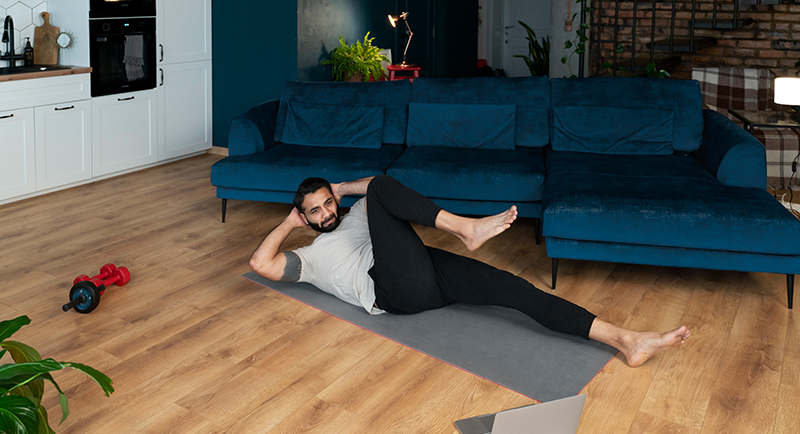5 exercises protecting prostate health
It’s not a secret that men can increase their chances of avoiding prostate problems by living a healthy lifestyle that includes regular exercise.
However, men who exercise, rarely are doing it for prostate health. Instead they do it for building muscle mass, bone health, heart health and for getting six-pack abs. So, it would be doubtful they are exercising specifically for a healthy prostate. Yet, when men engage in physical activity, they unknowingly promote their prostate health. These men will likely suffer less from benign prostatic hyperplasia (BPH) (an enlarged prostate), prostatitis (inflammation of the prostate), and are lessening their risk of prostate cancer progression if diagnosed with this disease.
A growing body of research agrees that prostate health is enhanced with regular exercise. For example, men, who have participated in the Health Professionals Follow-up Study and exercised consistently, were found to have less BPH and reduced their risk of erectile dysfunction by 20%.
Some men may question how much exercise is enough and what type of exercise is best?
To help understand what types and how much exercise men should focus on, here is a listing of 5 ideas to help clarify how to approach a prostate-focused exercise plan:
- Aerobic exercise for heart health
Men value sexual performance, but if erectile dysfunction is making it difficult, it’s time to add in aerobic exercise. That’s because aerobic (which means ‘with oxygen’) moves get the blood flowing as the heart speeds up with deep breathing supplying oxygenated blood to all body areas, including the penis. As the saying goes, ‘What’s good for the heart is good for sexual health.’ Engaging in at least 30 or up to 60 minutes most days of the week in moderate-to-high intensity aerobic exercise is recommended. Examples of aerobic exercise include swimming, brisk walking, hiking, playing tennis, basketball, racquetball, or biking. Aerobic exercise is excellent for burning calories, promoting heart health and good circulation, lowering blood pressure, and benefits prostate health .
2. High-Intensity Interval Training
Men who neglect physical activity are more apt to gain weight in their belly as visceral fat. Visceral fat, stored deep in the abdominal region, increases the risk of heart attacks and strokes and the risk of BPH and prostate cancer. While eating a healthy diet with plenty of fruits and vegetables can help reduce weight gain, the best way to get rid of belly fat is a combination of healthy foods and exercise. The best exercise to battle belly bulge is high-intensity interval training. Interval training relies on short bursts of brisk walking and then all-out sprinting. The idea is to switch back and forth between these moves for about 10-15 minutes. Interval training kick starts the body’s metabolism helping burn more body fat, especially stubborn belly fat. Perform high-intensity interval training at least twice a week.
3. Kegel exercises
Prostate health will benefit significantly from consistent Kegel exercises. Kegel exercises don’t raise heart rate or burn belly fat, but they are effective for men with symptoms of BPH or urinary incontinence. Even better, Kegels can be done anywhere at any time throughout the day. To do a Kegel, men simple squeeze the muscles used to stop urine flow. After squeezing these muscles, keep holding for at least 5-10 seconds, and then release. Repeat three sets of 10 Kegels daily to see the most benefits.
4. Weight training
More and more studies on weight or resistance training for prostate health are showing that men who lift weights will also indirectly benefit their prostate. Whether lifting dumbbells, kettlebells or using resistance bands, weight training can improve prostate health by:
- Increasing strength and endurance. Men undergoing rigorous treatment for prostate cancer will need the stamina and strength to endure these procedures.
- Improving and maintaining muscle mass. Studies have shown that resistance training in men with prostate cancer helps improve body composition, physical function, muscle strength, body mass index, and PSA levels.
- Maintaining bone density. Men can and do develop osteoporosis, especially with age. Men particularly at risk are those receiving hormone deprivation therapies for prostate cancer. This type of therapy is used to suppress male hormones, called androgens, depriving cancer cells what they need to grow. However, by blocking hormones such as testosterone which protects against bone loss, bones become less dense, putting men at risk for osteoporosis.
5. Exercise regularly
For exercise to be effective, do it consistently. The day in, day out consistency promotes muscle mass, bone density, cardiovascular health, and burns calories, promoting a healthy body weight. And for men with early-stage prostate cancer, exercising at least three times a week, helps activate more tumor-suppressing genes and the genes necessary to repair DNA than men who exercise less or not at all.
Men need to make time to find time to exercise. It’s that important. Each day, men should look for opportunities to squeeze in physical activity. It all adds up to health perk gains for the prostate when exercise becomes a priority in their life.
Dr. David Samadi is the Director of Men’s Health and Urologic Oncology at St. Francis Hospital in Long Island. He’s a renowned and highly successful board certified Urologic Oncologist Expert and Robotic Surgeon in New York City, regarded as one of the leading prostate surgeons in the U.S., with a vast expertise in prostate cancer treatment and Robotic-Assisted Laparoscopic Prostatectomy. Dr. Samadi is a medical contributor to NewsMax TV and is also the author of The Ultimate MANual, Dr. Samadi’s Guide to Men’s Health and Wellness, available online both on Amazon and Barnes & Noble. Visit Dr. Samadi’s websites at robotic oncolo gy and prostate cancer 911.

